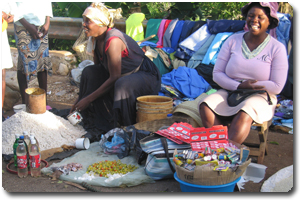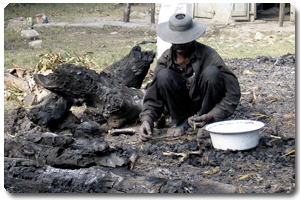A Visit to Haiti and Fonkoze by Edward Haley

Haiti and its people are so beautiful and so poor that spending time with them breaks a visitor's heart and takes away the ability to put thoughts and feelings in perspective. Since we returned from Haiti, I have been trying to find a frame for our experiences. I'm still trying.
With the kind assistance of members of Fonkoze, a micro-finance organization started in 1995 by Father Joseph Philippe and directed by Anne Hastings, Elaine and I spent five days, in Haiti, January 13-17, 2009, traveling from Port au Prince, the capital, to Mibale and Boukan Kare in the central plateau and Fondwa in the southwest. I went in my capacity as Director of the Center for Human Rights Leadership at Claremont McKenna College, seeking to establish a connection between the Center and Fonkoze, as part of the Center's efforts to establish links with effective human rights organizations. Elaine traveled with me at our personal expense. We came away deeply moved by what we saw and profoundly impressed by the achievements of Fonkoze. Since its founding Fonkoze has grown into an organization with a national reach, amassing 50,000 depositors and thousands of Ti Marchans, small traders, 99% of whom are women, a traditional role for women in Haiti. In addition to spending several hours with Anne Hastings and traveling with three members of her staff for four days, we talked at length with Father Joseph who has launched a new initiative, aimed at creating a university geared to the needs of the majority of Haiti's people, most of whom are impoverished farmers. I've attached some pictures along with these impressions of our stay.
Haiti is strikingly beautiful, despite the most severe environmental degradation, partly the result of cutting and burning trees for charcoal, the sole fuel for cooking for millions of Haitians. Hillsides and mountains everywhere have been stripped of trees, leaving their stone ribs painfully evident, as gaunt and stricken as many of the farm animals one sees in the fields and alongside the roads.
Even so, there are places, such as the central plateau, where the countryside smiles under blue skies and soft, high clouds, where there are fields covered with dark green rows of okra reached by trails that wander through stands of tall millet, sugar cane, and banana trees, a countryside so carefully tended and so filled with sun as to make an American visitor think of the south of France or Tuscany.

But it is the beauty of the people that stay most in the mind. The African origin of the Haitians one sees in the streets and villages shows in the luscious colors of their faces and limbs, every shade from the palest cafe au lait to purple black, and in the grace with which people walk, women and some men carrying an astonishing range of goods on their heads, as little as a book or two and as much as an ice chest or a tall basket filled with layer after layer of vegetables. Haitians come in every imaginable size and shape, but the physique that one remembers is of people who are tall, with square shoulders, big bottoms, and flat faces, the entrancing look of Michelle Obama. It is a shape that one has seen in exaggeration in the wood statues of African deities.
One remembers the people and their poverty, a poverty more severe than anything we had ever seen, a poverty so deep and so punishing that it shortens the lives of Haitians at every age and puts human beings and animals in competition for enough to eat. Haitians are young: the median age is 18; and they don't live very long. Haitians can expect to live to be only 57. Infant mortality in Haiti is 620 deaths/1,000 live births far greater than the 6.3 deaths/1,000 live births in the United States or the 2.75 deaths/1,000 in Sweden. By contrast to Haitians, Americans can expect to live to be 78, and the median age in the United States is 36.
It is impossible to travel far in Haiti before paved roads turn into dirt tracks of holes and ruts that force cars and trucks to a bone jolting crawl that continues past all enduring, or, as in Port au Prince, runs into torrents of water pouring down steep side streets, collecting every form of waste, turning a major boulevard into a shallow lake where filthy water is sprayed by passing cars and small buses (Tap-Taps) onto the goods of ti marchans who have set up for market on the ground for hundreds of meters along the side of the road.
"Does all this water come from a spring or a burst water main?"
"A burst water main. It's been this way for years. No one does anything about it."
All this occurs inside the first half hour after arrival, but one quickly finds that it is repeated endlessly: the beauty of the people and the land and the depth of their poverty, the grinding, jarring, wearing cost of every movement until visitors give in and begin to know the smallest part of what it means to be Haitian.
Thanks to Fonkoze we met dozens of Haitians and saw something else, something precious and full of hope for the future. In the solidarity groups that women form to support one another as they receive small loans from Fonkoze and work to repay them, we saw pride and success shining on the faces of the members. They met us with kisses. They reported that their children were in school, and they sang and laughed. That is the other thing that we remember about our time in Haiti: the laughter of the people, in Fonkoze's meetings, on the street, in tap-taps, passing by, sardonic, sad, or teasing, sometimes just laughter.

